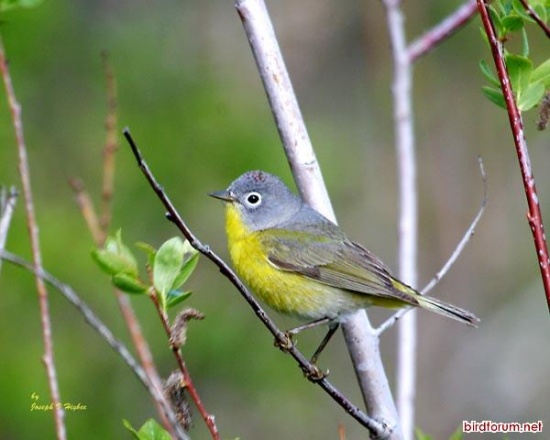m |
|||
| Line 1: | Line 1: | ||
| − | + | ||
;Vermivora ruficapilla | ;Vermivora ruficapilla | ||
| − | [[Image:Nashville_Warbler.jpg|thumb| | + | [[Image:Nashville_Warbler.jpg|thumb|550px|right|Photo by JV higbee]] |
| + | ==Identification== | ||
| + | Length: 4 inches Small, active, insect-eating bird Thin, very pointed bill White eye ring Yellow throat, breast, and undertail coverts White belly Olive upperparts No wing bars Rusty crown patch of male is rarely visible | ||
| + | Male has gray head, female and immature's is duller, more olive. It can be identified by its white eye ring, underparts pattern (yellow from throat to breast, white belly, and yellow undertail coverts), and lack of wing bars. | ||
| + | ==Distribution== | ||
| + | Nashville warblers breed in Canada and the northeastern and western United States of America. | ||
| + | They migrate to southernmost Texas, Mexico and Central America in winter. Although named after Nashville, Tennessee, the Nashville warbler only visits that area during migration. | ||
| + | ==Taxonomy== | ||
| + | ==Habitat== | ||
| + | Open mixed woods and bog habitats | ||
| + | ==Behaviour== | ||
| + | They conceal their open cup-shaped nests on the ground under shrubs. | ||
| + | |||
| + | They forage in the lower parts of trees and shrubs, frequently flicking their tails; these birds mainly eat insects. | ||
| + | |||
| + | The song of the eastern (typical) race of the Nashville warbler consists of a rapid seewit-seewit-seewit-ti-ti-ti. Males sing from open perches on the nesting territory. The call sounds like a high seet. Western birds, of the race ridgwayi, have a slightly lower-pitched, richer song, and a sharper call note. | ||
| + | |||
==External Links== | ==External Links== | ||
| + | |||
| + | |||
*[http://www.birdforum.net/pp_gallery/showgallery.php?mcats=all&what=allfields&si=Vermivora+ruficapilla+ View more images of Nashville Warbler in the gallery] | *[http://www.birdforum.net/pp_gallery/showgallery.php?mcats=all&what=allfields&si=Vermivora+ruficapilla+ View more images of Nashville Warbler in the gallery] | ||
[[Category:Birds]] | [[Category:Birds]] | ||
Revision as of 18:04, 22 June 2007
- Vermivora ruficapilla
Identification
Length: 4 inches Small, active, insect-eating bird Thin, very pointed bill White eye ring Yellow throat, breast, and undertail coverts White belly Olive upperparts No wing bars Rusty crown patch of male is rarely visible Male has gray head, female and immature's is duller, more olive. It can be identified by its white eye ring, underparts pattern (yellow from throat to breast, white belly, and yellow undertail coverts), and lack of wing bars.
Distribution
Nashville warblers breed in Canada and the northeastern and western United States of America. They migrate to southernmost Texas, Mexico and Central America in winter. Although named after Nashville, Tennessee, the Nashville warbler only visits that area during migration.
Taxonomy
Habitat
Open mixed woods and bog habitats
Behaviour
They conceal their open cup-shaped nests on the ground under shrubs.
They forage in the lower parts of trees and shrubs, frequently flicking their tails; these birds mainly eat insects.
The song of the eastern (typical) race of the Nashville warbler consists of a rapid seewit-seewit-seewit-ti-ti-ti. Males sing from open perches on the nesting territory. The call sounds like a high seet. Western birds, of the race ridgwayi, have a slightly lower-pitched, richer song, and a sharper call note.




